Comprehensive Analysis of Data Methods and Their Applications
VerifiedAdded on 2021/02/19
|9
|2319
|125
Report
AI Summary
This report provides a comprehensive overview of data analysis methods, encompassing both qualitative and quantitative approaches. It begins with an introduction to data analysis, emphasizing its importance in decision-making processes within businesses. The report then delves into the methods of qualitative data analysis, including content analysis, narrative analysis, and discourse analysis, explaining their applications and benefits. Following this, the report explores quantitative data analysis, detailing the steps involved in data preparation, such as data validation, editing, and coding. It then discusses various quantitative data analysis methods, including descriptive statistics (mean, median, mode, percentage, frequency, range), regression analysis, hypothesis testing, and Monte Carlo simulation. Each method is explained with its purpose and application. The report concludes by summarizing the importance of data analysis in drawing meaningful conclusions and making informed decisions, highlighting the significance of both qualitative and quantitative methods in research and business contexts.
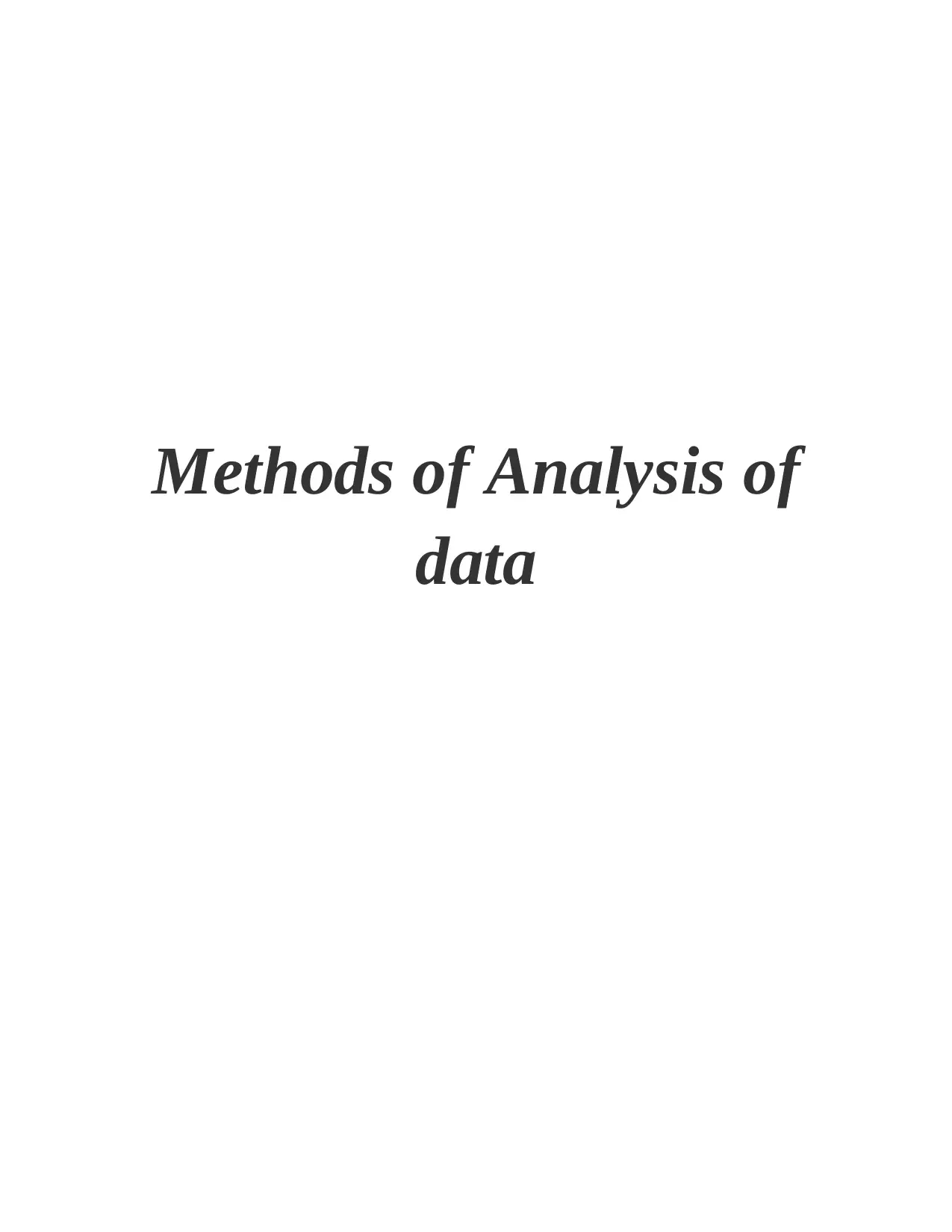
Methods of Analysis of
data
data
Paraphrase This Document
Need a fresh take? Get an instant paraphrase of this document with our AI Paraphraser
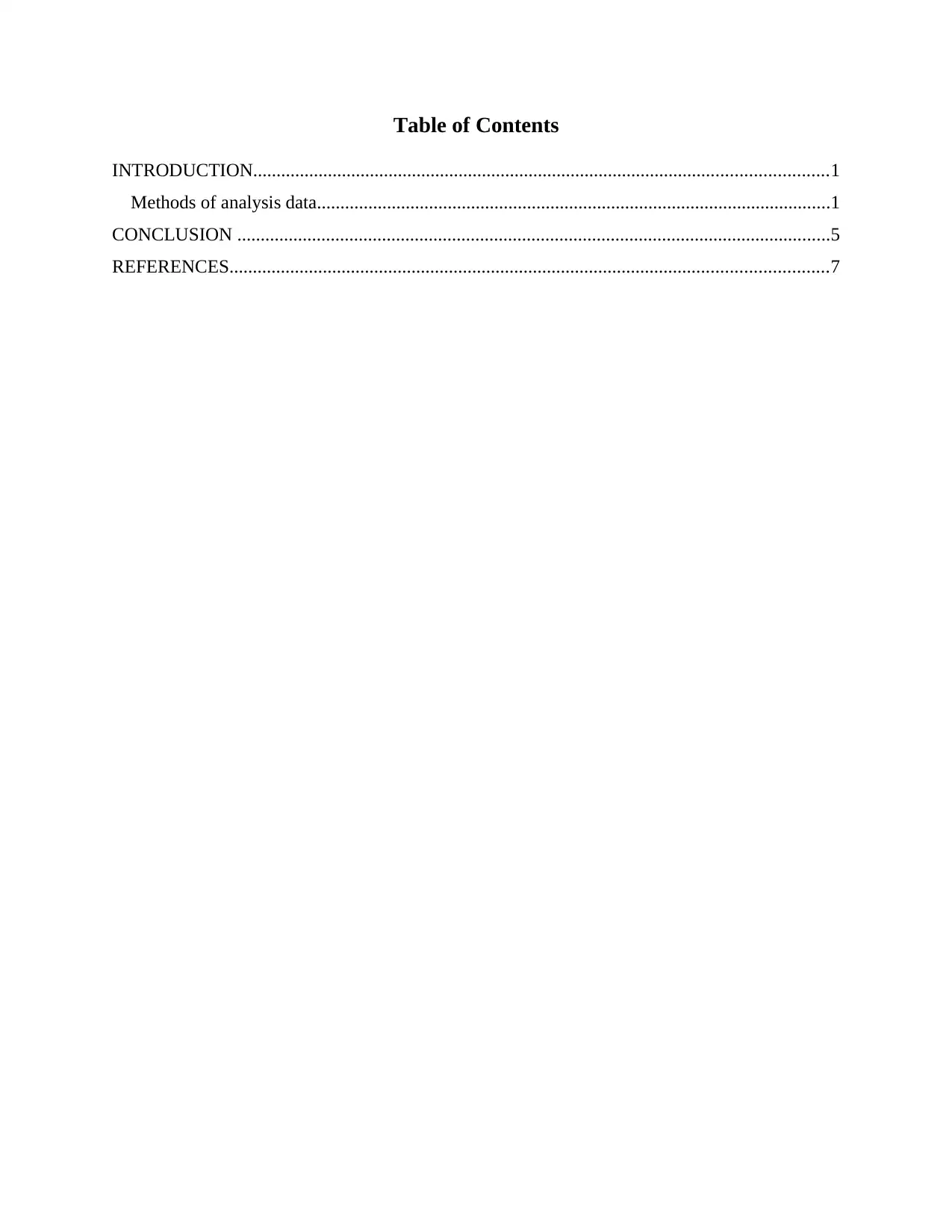
Table of Contents
INTRODUCTION...........................................................................................................................1
Methods of analysis data..............................................................................................................1
CONCLUSION ...............................................................................................................................5
REFERENCES................................................................................................................................7
INTRODUCTION...........................................................................................................................1
Methods of analysis data..............................................................................................................1
CONCLUSION ...............................................................................................................................5
REFERENCES................................................................................................................................7
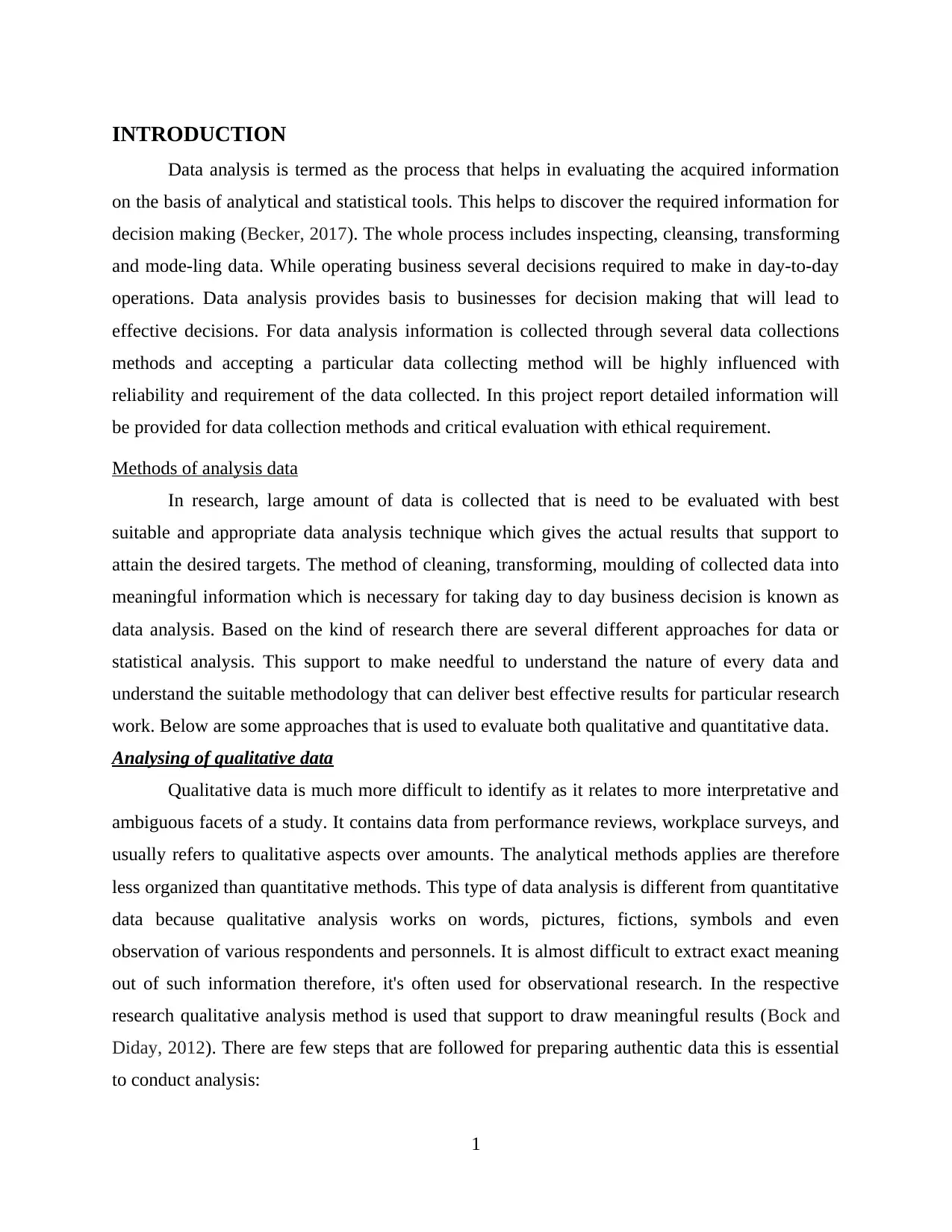
INTRODUCTION
Data analysis is termed as the process that helps in evaluating the acquired information
on the basis of analytical and statistical tools. This helps to discover the required information for
decision making (Becker, 2017). The whole process includes inspecting, cleansing, transforming
and mode-ling data. While operating business several decisions required to make in day-to-day
operations. Data analysis provides basis to businesses for decision making that will lead to
effective decisions. For data analysis information is collected through several data collections
methods and accepting a particular data collecting method will be highly influenced with
reliability and requirement of the data collected. In this project report detailed information will
be provided for data collection methods and critical evaluation with ethical requirement.
Methods of analysis data
In research, large amount of data is collected that is need to be evaluated with best
suitable and appropriate data analysis technique which gives the actual results that support to
attain the desired targets. The method of cleaning, transforming, moulding of collected data into
meaningful information which is necessary for taking day to day business decision is known as
data analysis. Based on the kind of research there are several different approaches for data or
statistical analysis. This support to make needful to understand the nature of every data and
understand the suitable methodology that can deliver best effective results for particular research
work. Below are some approaches that is used to evaluate both qualitative and quantitative data.
Analysing of qualitative data
Qualitative data is much more difficult to identify as it relates to more interpretative and
ambiguous facets of a study. It contains data from performance reviews, workplace surveys, and
usually refers to qualitative aspects over amounts. The analytical methods applies are therefore
less organized than quantitative methods. This type of data analysis is different from quantitative
data because qualitative analysis works on words, pictures, fictions, symbols and even
observation of various respondents and personnels. It is almost difficult to extract exact meaning
out of such information therefore, it's often used for observational research. In the respective
research qualitative analysis method is used that support to draw meaningful results (Bock and
Diday, 2012). There are few steps that are followed for preparing authentic data this is essential
to conduct analysis:
1
Data analysis is termed as the process that helps in evaluating the acquired information
on the basis of analytical and statistical tools. This helps to discover the required information for
decision making (Becker, 2017). The whole process includes inspecting, cleansing, transforming
and mode-ling data. While operating business several decisions required to make in day-to-day
operations. Data analysis provides basis to businesses for decision making that will lead to
effective decisions. For data analysis information is collected through several data collections
methods and accepting a particular data collecting method will be highly influenced with
reliability and requirement of the data collected. In this project report detailed information will
be provided for data collection methods and critical evaluation with ethical requirement.
Methods of analysis data
In research, large amount of data is collected that is need to be evaluated with best
suitable and appropriate data analysis technique which gives the actual results that support to
attain the desired targets. The method of cleaning, transforming, moulding of collected data into
meaningful information which is necessary for taking day to day business decision is known as
data analysis. Based on the kind of research there are several different approaches for data or
statistical analysis. This support to make needful to understand the nature of every data and
understand the suitable methodology that can deliver best effective results for particular research
work. Below are some approaches that is used to evaluate both qualitative and quantitative data.
Analysing of qualitative data
Qualitative data is much more difficult to identify as it relates to more interpretative and
ambiguous facets of a study. It contains data from performance reviews, workplace surveys, and
usually refers to qualitative aspects over amounts. The analytical methods applies are therefore
less organized than quantitative methods. This type of data analysis is different from quantitative
data because qualitative analysis works on words, pictures, fictions, symbols and even
observation of various respondents and personnels. It is almost difficult to extract exact meaning
out of such information therefore, it's often used for observational research. In the respective
research qualitative analysis method is used that support to draw meaningful results (Bock and
Diday, 2012). There are few steps that are followed for preparing authentic data this is essential
to conduct analysis:
1
⊘ This is a preview!⊘
Do you want full access?
Subscribe today to unlock all pages.

Trusted by 1+ million students worldwide
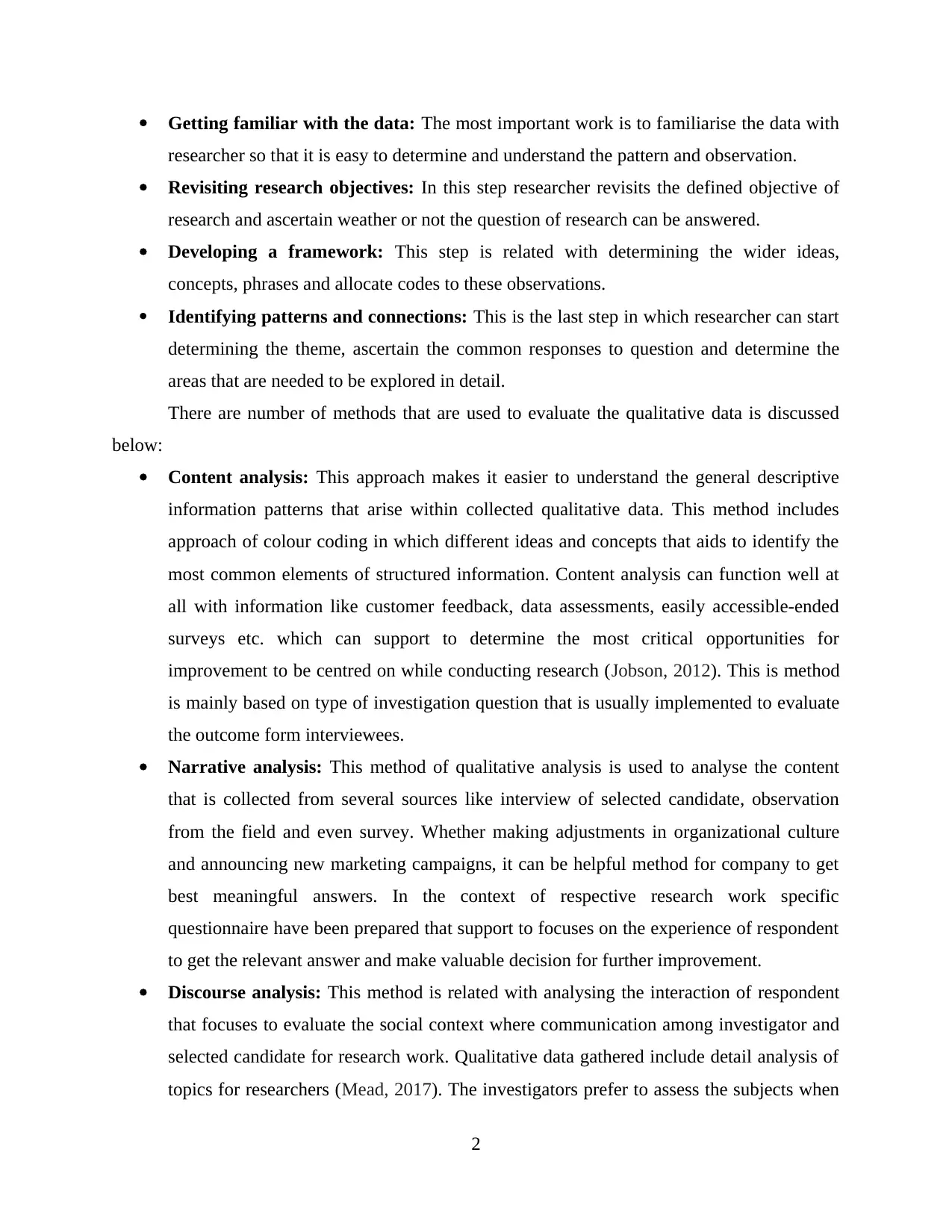
Getting familiar with the data: The most important work is to familiarise the data with
researcher so that it is easy to determine and understand the pattern and observation.
Revisiting research objectives: In this step researcher revisits the defined objective of
research and ascertain weather or not the question of research can be answered.
Developing a framework: This step is related with determining the wider ideas,
concepts, phrases and allocate codes to these observations.
Identifying patterns and connections: This is the last step in which researcher can start
determining the theme, ascertain the common responses to question and determine the
areas that are needed to be explored in detail.
There are number of methods that are used to evaluate the qualitative data is discussed
below:
Content analysis: This approach makes it easier to understand the general descriptive
information patterns that arise within collected qualitative data. This method includes
approach of colour coding in which different ideas and concepts that aids to identify the
most common elements of structured information. Content analysis can function well at
all with information like customer feedback, data assessments, easily accessible-ended
surveys etc. which can support to determine the most critical opportunities for
improvement to be centred on while conducting research (Jobson, 2012). This is method
is mainly based on type of investigation question that is usually implemented to evaluate
the outcome form interviewees.
Narrative analysis: This method of qualitative analysis is used to analyse the content
that is collected from several sources like interview of selected candidate, observation
from the field and even survey. Whether making adjustments in organizational culture
and announcing new marketing campaigns, it can be helpful method for company to get
best meaningful answers. In the context of respective research work specific
questionnaire have been prepared that support to focuses on the experience of respondent
to get the relevant answer and make valuable decision for further improvement.
Discourse analysis: This method is related with analysing the interaction of respondent
that focuses to evaluate the social context where communication among investigator and
selected candidate for research work. Qualitative data gathered include detail analysis of
topics for researchers (Mead, 2017). The investigators prefer to assess the subjects when
2
researcher so that it is easy to determine and understand the pattern and observation.
Revisiting research objectives: In this step researcher revisits the defined objective of
research and ascertain weather or not the question of research can be answered.
Developing a framework: This step is related with determining the wider ideas,
concepts, phrases and allocate codes to these observations.
Identifying patterns and connections: This is the last step in which researcher can start
determining the theme, ascertain the common responses to question and determine the
areas that are needed to be explored in detail.
There are number of methods that are used to evaluate the qualitative data is discussed
below:
Content analysis: This approach makes it easier to understand the general descriptive
information patterns that arise within collected qualitative data. This method includes
approach of colour coding in which different ideas and concepts that aids to identify the
most common elements of structured information. Content analysis can function well at
all with information like customer feedback, data assessments, easily accessible-ended
surveys etc. which can support to determine the most critical opportunities for
improvement to be centred on while conducting research (Jobson, 2012). This is method
is mainly based on type of investigation question that is usually implemented to evaluate
the outcome form interviewees.
Narrative analysis: This method of qualitative analysis is used to analyse the content
that is collected from several sources like interview of selected candidate, observation
from the field and even survey. Whether making adjustments in organizational culture
and announcing new marketing campaigns, it can be helpful method for company to get
best meaningful answers. In the context of respective research work specific
questionnaire have been prepared that support to focuses on the experience of respondent
to get the relevant answer and make valuable decision for further improvement.
Discourse analysis: This method is related with analysing the interaction of respondent
that focuses to evaluate the social context where communication among investigator and
selected candidate for research work. Qualitative data gathered include detail analysis of
topics for researchers (Mead, 2017). The investigators prefer to assess the subjects when
2
Paraphrase This Document
Need a fresh take? Get an instant paraphrase of this document with our AI Paraphraser
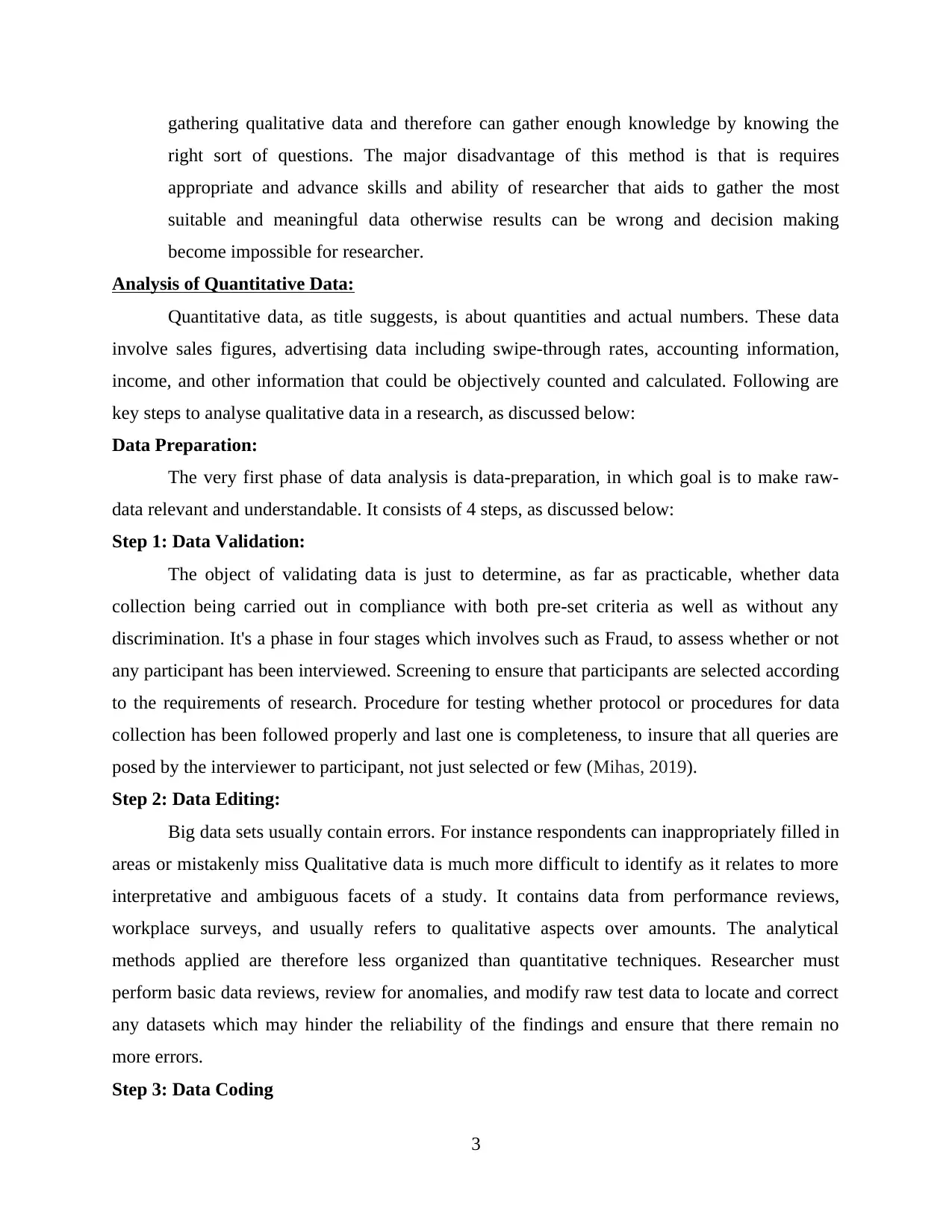
gathering qualitative data and therefore can gather enough knowledge by knowing the
right sort of questions. The major disadvantage of this method is that is requires
appropriate and advance skills and ability of researcher that aids to gather the most
suitable and meaningful data otherwise results can be wrong and decision making
become impossible for researcher.
Analysis of Quantitative Data:
Quantitative data, as title suggests, is about quantities and actual numbers. These data
involve sales figures, advertising data including swipe-through rates, accounting information,
income, and other information that could be objectively counted and calculated. Following are
key steps to analyse qualitative data in a research, as discussed below:
Data Preparation:
The very first phase of data analysis is data-preparation, in which goal is to make raw-
data relevant and understandable. It consists of 4 steps, as discussed below:
Step 1: Data Validation:
The object of validating data is just to determine, as far as practicable, whether data
collection being carried out in compliance with both pre-set criteria as well as without any
discrimination. It's a phase in four stages which involves such as Fraud, to assess whether or not
any participant has been interviewed. Screening to ensure that participants are selected according
to the requirements of research. Procedure for testing whether protocol or procedures for data
collection has been followed properly and last one is completeness, to insure that all queries are
posed by the interviewer to participant, not just selected or few (Mihas, 2019).
Step 2: Data Editing:
Big data sets usually contain errors. For instance respondents can inappropriately filled in
areas or mistakenly miss Qualitative data is much more difficult to identify as it relates to more
interpretative and ambiguous facets of a study. It contains data from performance reviews,
workplace surveys, and usually refers to qualitative aspects over amounts. The analytical
methods applied are therefore less organized than quantitative techniques. Researcher must
perform basic data reviews, review for anomalies, and modify raw test data to locate and correct
any datasets which may hinder the reliability of the findings and ensure that there remain no
more errors.
Step 3: Data Coding
3
right sort of questions. The major disadvantage of this method is that is requires
appropriate and advance skills and ability of researcher that aids to gather the most
suitable and meaningful data otherwise results can be wrong and decision making
become impossible for researcher.
Analysis of Quantitative Data:
Quantitative data, as title suggests, is about quantities and actual numbers. These data
involve sales figures, advertising data including swipe-through rates, accounting information,
income, and other information that could be objectively counted and calculated. Following are
key steps to analyse qualitative data in a research, as discussed below:
Data Preparation:
The very first phase of data analysis is data-preparation, in which goal is to make raw-
data relevant and understandable. It consists of 4 steps, as discussed below:
Step 1: Data Validation:
The object of validating data is just to determine, as far as practicable, whether data
collection being carried out in compliance with both pre-set criteria as well as without any
discrimination. It's a phase in four stages which involves such as Fraud, to assess whether or not
any participant has been interviewed. Screening to ensure that participants are selected according
to the requirements of research. Procedure for testing whether protocol or procedures for data
collection has been followed properly and last one is completeness, to insure that all queries are
posed by the interviewer to participant, not just selected or few (Mihas, 2019).
Step 2: Data Editing:
Big data sets usually contain errors. For instance respondents can inappropriately filled in
areas or mistakenly miss Qualitative data is much more difficult to identify as it relates to more
interpretative and ambiguous facets of a study. It contains data from performance reviews,
workplace surveys, and usually refers to qualitative aspects over amounts. The analytical
methods applied are therefore less organized than quantitative techniques. Researcher must
perform basic data reviews, review for anomalies, and modify raw test data to locate and correct
any datasets which may hinder the reliability of the findings and ensure that there remain no
more errors.
Step 3: Data Coding
3
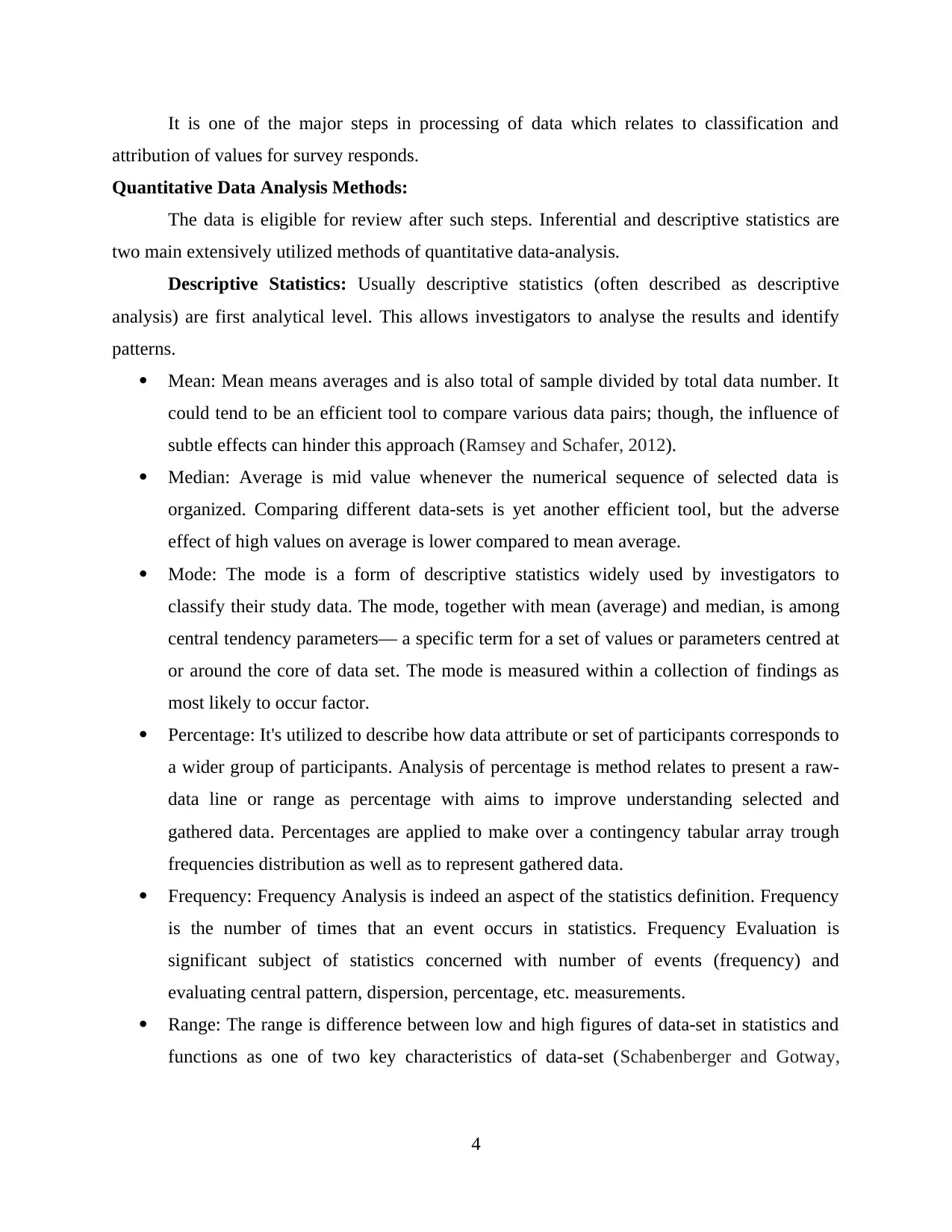
It is one of the major steps in processing of data which relates to classification and
attribution of values for survey responds.
Quantitative Data Analysis Methods:
The data is eligible for review after such steps. Inferential and descriptive statistics are
two main extensively utilized methods of quantitative data-analysis.
Descriptive Statistics: Usually descriptive statistics (often described as descriptive
analysis) are first analytical level. This allows investigators to analyse the results and identify
patterns.
Mean: Mean means averages and is also total of sample divided by total data number. It
could tend to be an efficient tool to compare various data pairs; though, the influence of
subtle effects can hinder this approach (Ramsey and Schafer, 2012).
Median: Average is mid value whenever the numerical sequence of selected data is
organized. Comparing different data-sets is yet another efficient tool, but the adverse
effect of high values on average is lower compared to mean average.
Mode: The mode is a form of descriptive statistics widely used by investigators to
classify their study data. The mode, together with mean (average) and median, is among
central tendency parameters— a specific term for a set of values or parameters centred at
or around the core of data set. The mode is measured within a collection of findings as
most likely to occur factor.
Percentage: It's utilized to describe how data attribute or set of participants corresponds to
a wider group of participants. Analysis of percentage is method relates to present a raw-
data line or range as percentage with aims to improve understanding selected and
gathered data. Percentages are applied to make over a contingency tabular array trough
frequencies distribution as well as to represent gathered data.
Frequency: Frequency Analysis is indeed an aspect of the statistics definition. Frequency
is the number of times that an event occurs in statistics. Frequency Evaluation is
significant subject of statistics concerned with number of events (frequency) and
evaluating central pattern, dispersion, percentage, etc. measurements.
Range: The range is difference between low and high figures of data-set in statistics and
functions as one of two key characteristics of data-set (Schabenberger and Gotway,
4
attribution of values for survey responds.
Quantitative Data Analysis Methods:
The data is eligible for review after such steps. Inferential and descriptive statistics are
two main extensively utilized methods of quantitative data-analysis.
Descriptive Statistics: Usually descriptive statistics (often described as descriptive
analysis) are first analytical level. This allows investigators to analyse the results and identify
patterns.
Mean: Mean means averages and is also total of sample divided by total data number. It
could tend to be an efficient tool to compare various data pairs; though, the influence of
subtle effects can hinder this approach (Ramsey and Schafer, 2012).
Median: Average is mid value whenever the numerical sequence of selected data is
organized. Comparing different data-sets is yet another efficient tool, but the adverse
effect of high values on average is lower compared to mean average.
Mode: The mode is a form of descriptive statistics widely used by investigators to
classify their study data. The mode, together with mean (average) and median, is among
central tendency parameters— a specific term for a set of values or parameters centred at
or around the core of data set. The mode is measured within a collection of findings as
most likely to occur factor.
Percentage: It's utilized to describe how data attribute or set of participants corresponds to
a wider group of participants. Analysis of percentage is method relates to present a raw-
data line or range as percentage with aims to improve understanding selected and
gathered data. Percentages are applied to make over a contingency tabular array trough
frequencies distribution as well as to represent gathered data.
Frequency: Frequency Analysis is indeed an aspect of the statistics definition. Frequency
is the number of times that an event occurs in statistics. Frequency Evaluation is
significant subject of statistics concerned with number of events (frequency) and
evaluating central pattern, dispersion, percentage, etc. measurements.
Range: The range is difference between low and high figures of data-set in statistics and
functions as one of two key characteristics of data-set (Schabenberger and Gotway,
4
⊘ This is a preview!⊘
Do you want full access?
Subscribe today to unlock all pages.

Trusted by 1+ million students worldwide
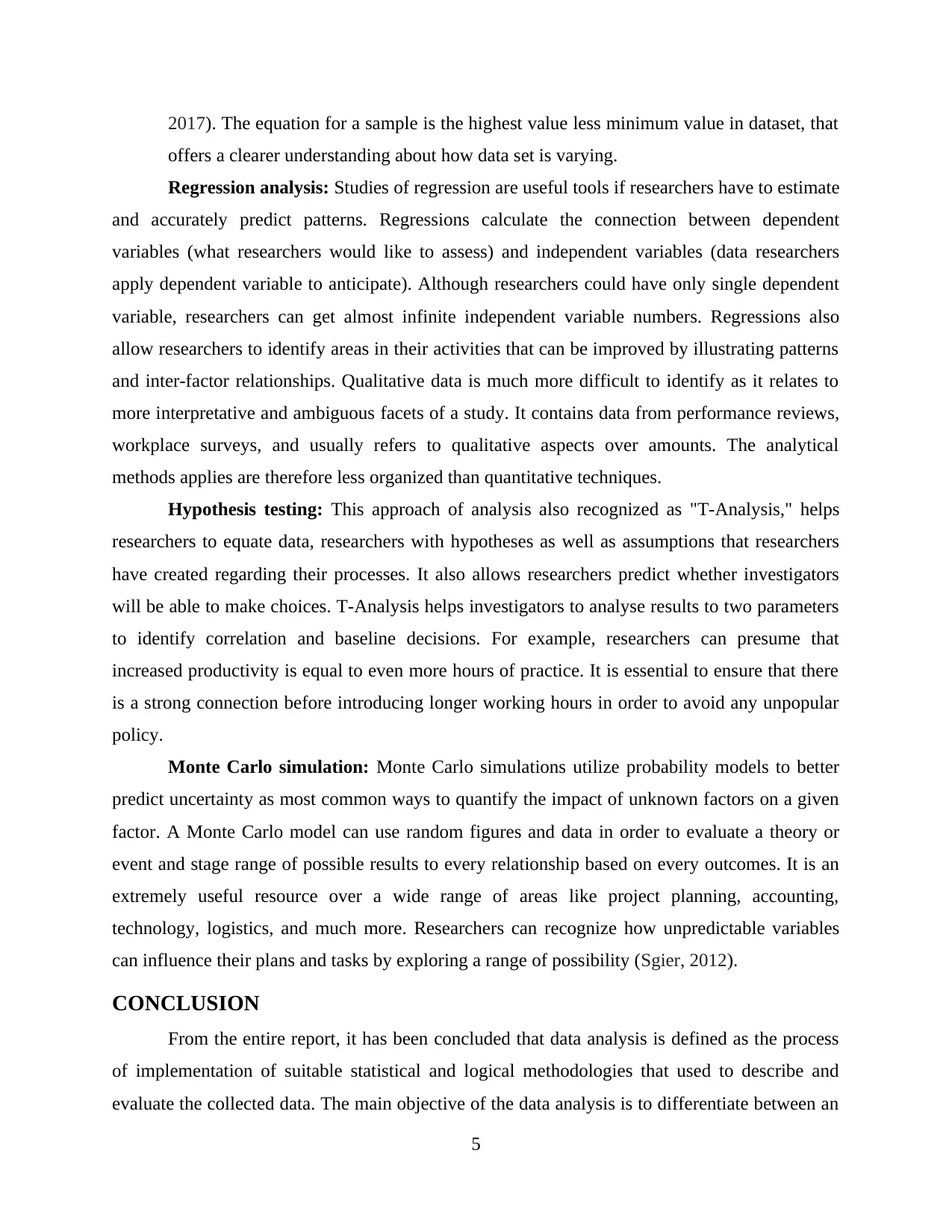
2017). The equation for a sample is the highest value less minimum value in dataset, that
offers a clearer understanding about how data set is varying.
Regression analysis: Studies of regression are useful tools if researchers have to estimate
and accurately predict patterns. Regressions calculate the connection between dependent
variables (what researchers would like to assess) and independent variables (data researchers
apply dependent variable to anticipate). Although researchers could have only single dependent
variable, researchers can get almost infinite independent variable numbers. Regressions also
allow researchers to identify areas in their activities that can be improved by illustrating patterns
and inter-factor relationships. Qualitative data is much more difficult to identify as it relates to
more interpretative and ambiguous facets of a study. It contains data from performance reviews,
workplace surveys, and usually refers to qualitative aspects over amounts. The analytical
methods applies are therefore less organized than quantitative techniques.
Hypothesis testing: This approach of analysis also recognized as "T-Analysis," helps
researchers to equate data, researchers with hypotheses as well as assumptions that researchers
have created regarding their processes. It also allows researchers predict whether investigators
will be able to make choices. T-Analysis helps investigators to analyse results to two parameters
to identify correlation and baseline decisions. For example, researchers can presume that
increased productivity is equal to even more hours of practice. It is essential to ensure that there
is a strong connection before introducing longer working hours in order to avoid any unpopular
policy.
Monte Carlo simulation: Monte Carlo simulations utilize probability models to better
predict uncertainty as most common ways to quantify the impact of unknown factors on a given
factor. A Monte Carlo model can use random figures and data in order to evaluate a theory or
event and stage range of possible results to every relationship based on every outcomes. It is an
extremely useful resource over a wide range of areas like project planning, accounting,
technology, logistics, and much more. Researchers can recognize how unpredictable variables
can influence their plans and tasks by exploring a range of possibility (Sgier, 2012).
CONCLUSION
From the entire report, it has been concluded that data analysis is defined as the process
of implementation of suitable statistical and logical methodologies that used to describe and
evaluate the collected data. The main objective of the data analysis is to differentiate between an
5
offers a clearer understanding about how data set is varying.
Regression analysis: Studies of regression are useful tools if researchers have to estimate
and accurately predict patterns. Regressions calculate the connection between dependent
variables (what researchers would like to assess) and independent variables (data researchers
apply dependent variable to anticipate). Although researchers could have only single dependent
variable, researchers can get almost infinite independent variable numbers. Regressions also
allow researchers to identify areas in their activities that can be improved by illustrating patterns
and inter-factor relationships. Qualitative data is much more difficult to identify as it relates to
more interpretative and ambiguous facets of a study. It contains data from performance reviews,
workplace surveys, and usually refers to qualitative aspects over amounts. The analytical
methods applies are therefore less organized than quantitative techniques.
Hypothesis testing: This approach of analysis also recognized as "T-Analysis," helps
researchers to equate data, researchers with hypotheses as well as assumptions that researchers
have created regarding their processes. It also allows researchers predict whether investigators
will be able to make choices. T-Analysis helps investigators to analyse results to two parameters
to identify correlation and baseline decisions. For example, researchers can presume that
increased productivity is equal to even more hours of practice. It is essential to ensure that there
is a strong connection before introducing longer working hours in order to avoid any unpopular
policy.
Monte Carlo simulation: Monte Carlo simulations utilize probability models to better
predict uncertainty as most common ways to quantify the impact of unknown factors on a given
factor. A Monte Carlo model can use random figures and data in order to evaluate a theory or
event and stage range of possible results to every relationship based on every outcomes. It is an
extremely useful resource over a wide range of areas like project planning, accounting,
technology, logistics, and much more. Researchers can recognize how unpredictable variables
can influence their plans and tasks by exploring a range of possibility (Sgier, 2012).
CONCLUSION
From the entire report, it has been concluded that data analysis is defined as the process
of implementation of suitable statistical and logical methodologies that used to describe and
evaluate the collected data. The main objective of the data analysis is to differentiate between an
5
Paraphrase This Document
Need a fresh take? Get an instant paraphrase of this document with our AI Paraphraser
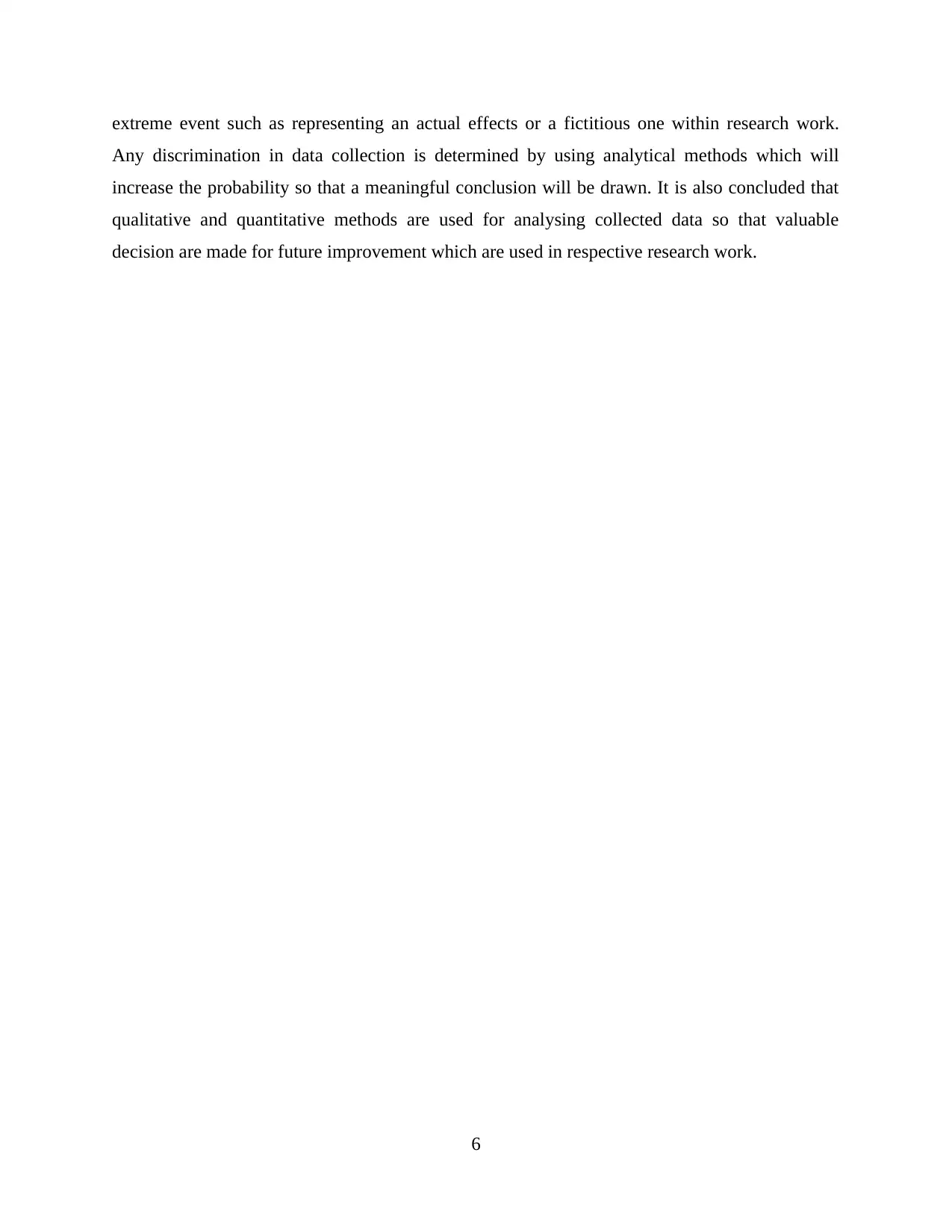
extreme event such as representing an actual effects or a fictitious one within research work.
Any discrimination in data collection is determined by using analytical methods which will
increase the probability so that a meaningful conclusion will be drawn. It is also concluded that
qualitative and quantitative methods are used for analysing collected data so that valuable
decision are made for future improvement which are used in respective research work.
6
Any discrimination in data collection is determined by using analytical methods which will
increase the probability so that a meaningful conclusion will be drawn. It is also concluded that
qualitative and quantitative methods are used for analysing collected data so that valuable
decision are made for future improvement which are used in respective research work.
6
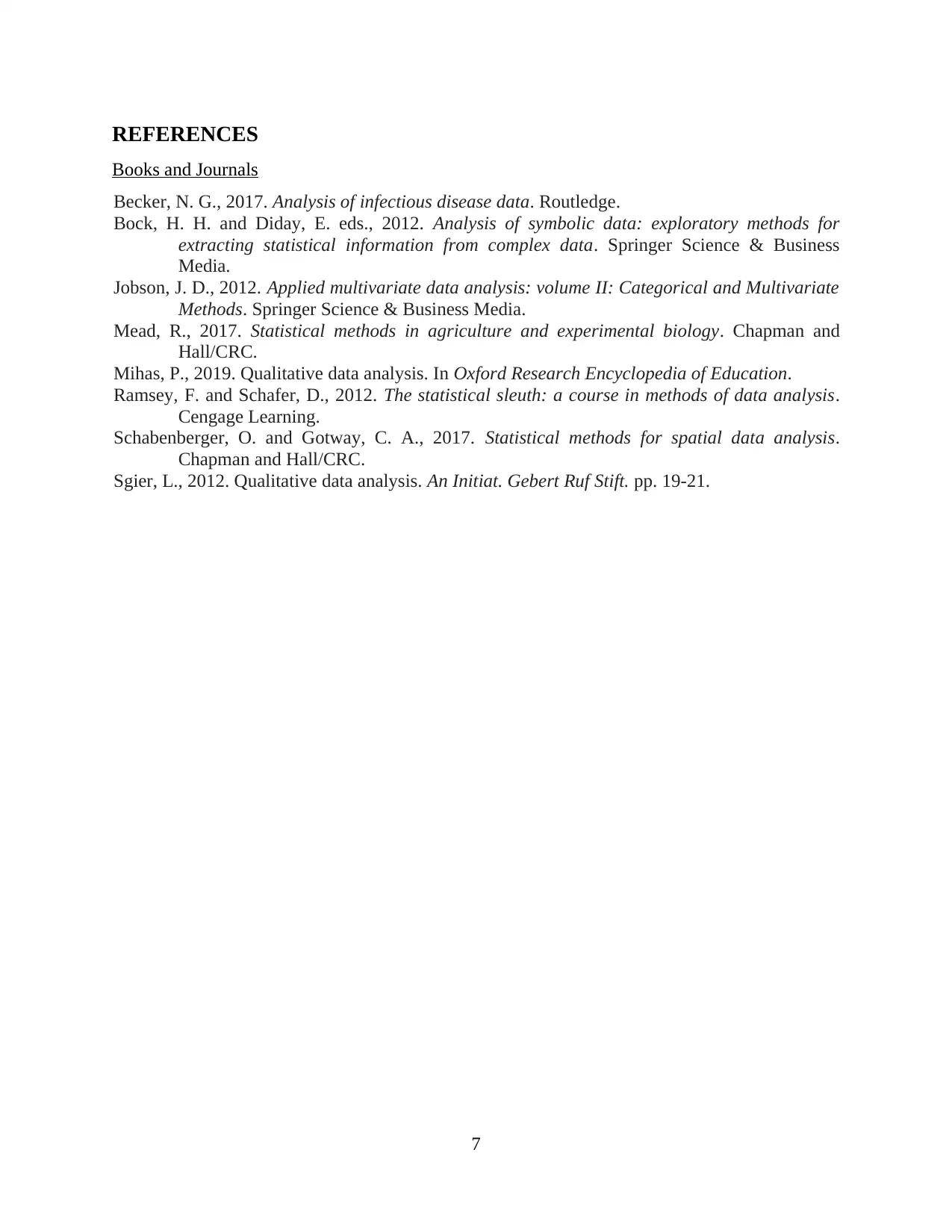
REFERENCES
Books and Journals
Becker, N. G., 2017. Analysis of infectious disease data. Routledge.
Bock, H. H. and Diday, E. eds., 2012. Analysis of symbolic data: exploratory methods for
extracting statistical information from complex data. Springer Science & Business
Media.
Jobson, J. D., 2012. Applied multivariate data analysis: volume II: Categorical and Multivariate
Methods. Springer Science & Business Media.
Mead, R., 2017. Statistical methods in agriculture and experimental biology. Chapman and
Hall/CRC.
Mihas, P., 2019. Qualitative data analysis. In Oxford Research Encyclopedia of Education.
Ramsey, F. and Schafer, D., 2012. The statistical sleuth: a course in methods of data analysis.
Cengage Learning.
Schabenberger, O. and Gotway, C. A., 2017. Statistical methods for spatial data analysis.
Chapman and Hall/CRC.
Sgier, L., 2012. Qualitative data analysis. An Initiat. Gebert Ruf Stift. pp. 19-21.
7
Books and Journals
Becker, N. G., 2017. Analysis of infectious disease data. Routledge.
Bock, H. H. and Diday, E. eds., 2012. Analysis of symbolic data: exploratory methods for
extracting statistical information from complex data. Springer Science & Business
Media.
Jobson, J. D., 2012. Applied multivariate data analysis: volume II: Categorical and Multivariate
Methods. Springer Science & Business Media.
Mead, R., 2017. Statistical methods in agriculture and experimental biology. Chapman and
Hall/CRC.
Mihas, P., 2019. Qualitative data analysis. In Oxford Research Encyclopedia of Education.
Ramsey, F. and Schafer, D., 2012. The statistical sleuth: a course in methods of data analysis.
Cengage Learning.
Schabenberger, O. and Gotway, C. A., 2017. Statistical methods for spatial data analysis.
Chapman and Hall/CRC.
Sgier, L., 2012. Qualitative data analysis. An Initiat. Gebert Ruf Stift. pp. 19-21.
7
⊘ This is a preview!⊘
Do you want full access?
Subscribe today to unlock all pages.

Trusted by 1+ million students worldwide
1 out of 9
Related Documents
Your All-in-One AI-Powered Toolkit for Academic Success.
+13062052269
info@desklib.com
Available 24*7 on WhatsApp / Email
![[object Object]](/_next/static/media/star-bottom.7253800d.svg)
Unlock your academic potential
Copyright © 2020–2025 A2Z Services. All Rights Reserved. Developed and managed by ZUCOL.




